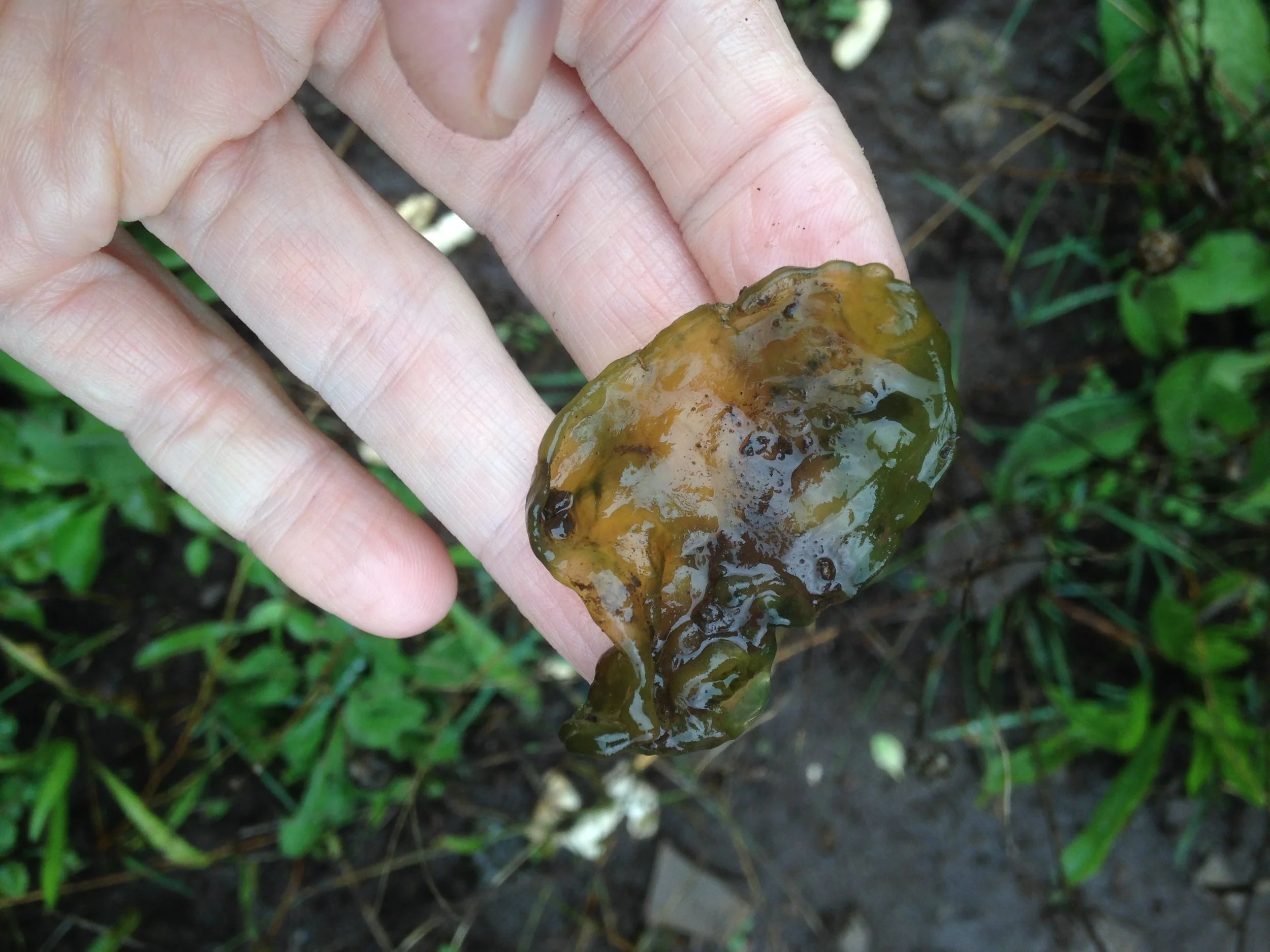Study in Cyanobacteria
It was green and ..snotty, but a little more solid. Like someone coughed up some strange phlegmy goo and it got rained on for a while. I didn’t see it, but I think others had mentioned that there was more hidden amidst the grasses, limestone shale and small forbs.
This goo has had many names, including Star Jelly, Star Shot, and Star Slime, Troll’s Butter, Witch’s Butter (not the fungi), and Witch’s Jelly. It is more formally known as Nostoc, which is the genus name of this really interesting cyanobacteria.
First a little about cyanobacterias. Cyanobacteria were formerly known as “blue-green algae” but they are not true algaes. Algae is a eukaryotic (has a nucleus) but cyanobacterias are prokaryots (do not have a nucleus). Also, algae have been dated back to about 2 billion years ago in the fossil records, but cyanobacteria are even older with known fossils coming in at 3.5 billion years ago. Some younger species which came about after those really old ones played a role in the oxygenation of the atmosphere, which of course created the conditions for plants and animals to develop, thrive, and evolve.
They are photosynthesizers and therefore help sequester carbon from the atmosphere , but at what scale is uncertain. It is likely that trees and plants do more carbon sequestration than the cyanobacteria.
Cyanobacterias are found mostly in aquatic environments but they can be found on and in the soil, and even in stone (cryptoendolithic rocks). These are pretty amazing microscopic life forms, which have and do survive in some of the most challenging environments on Earth. Despite being able to survive in harsh arctic climates, and being one of the earliest life forms on Earth, there are species of cyanobacteria who are native to the Great Lakes bioregion, and could be found almost everywhere, except they are often too small to notice. Unless they “bloom”, meaning they have reached high levels of population abundance to the point that we can now see them. A bloom can take the form of long filaments, cloudiness in water, blobs, and films on top of waterbodies.
Blooms are actually increasing because of changing environmental conditions (stagnant water, high levels of rain + high temperatures), sources of excess nutrients (more nitrogen and phosperous usually from fertilizers and livestock waste), climate change (global warming, increases in droughts and flooding, increased CO2).
While cyanobacteria are fairly novel to me, there are some species which I do know a little bit about, such as Spirulina and now Nostoc. Some species produce cyanotoxins, but not all species, and some strains of cyanotoxin producing cyanobacteria do not produce the toxins. Spirulina and Nostoc can produce microsystins which can cause serious damage to the liver if ingested, and eventually lead to stomach pain, vomiting, diarrhea, headache, blistering around the mouth. Sore throat, dry cough, and pneumonia can all develop if inhaled. I don't know how much needs to be inhaled, or ingested, but it seems there are very few cases of poisoning from what I am reading but this is because of water quality standards and access to clean drinking water in most municipalities. Complex and weird, but that's why I am interested in them.
Nostoc can create mucilaginous cell surfaces which allow many cells to chain together to form long filaments. The filaments can come together in gelatinous colonies built of carbohydrates with molecules consisting of a number of sugar molecules bonded together. The goo you see in the hands in the photos are these colonies (we all washed our hands afterwards).
Each Nostoc cell contains chlorophyll, but some special cells called “heterocysts” are formed within the aforementioned filaments. The heterocysts can fix nitrogen from the atmosphere and pass it down the filaments to the smaller cyanobacteria cells who use the nitrogen to build amino acids, and proteins. The cyanobacteria in turn pass carbohydrates back to the heterocysts. A team of cells looking out for one another.
Nostoc can live either in aquatic environments, or terrestrial environments. They can dehydrate in tougher environmental conditions, turning into a shriveled up blackish-green crust, but when the rains come, like they have been around here as of late, they rehydrate and return this slimy gooey snot body. What a lovely creation. Nostoc is probably a lot more common then what is represented by my experience on the land. It’s just I havn’t been looking, but now I will be looking everywhere.
To learn more :
Cyanobacteria : What you need to know video
Toxic Cyanobacteria of New England
Wikipedia page on Microsystins


